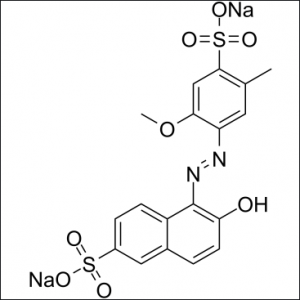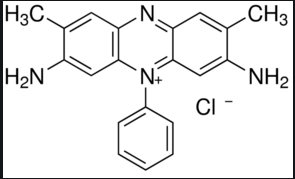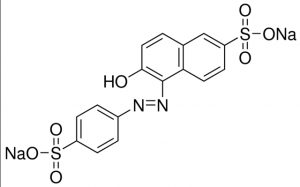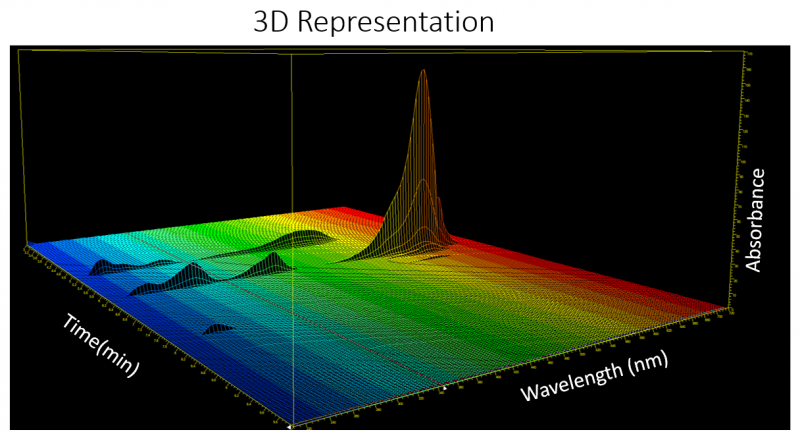Difference between revisions of "Final Research Paper"
| (15 intermediate revisions by 2 users not shown) | |||
| Line 1: | Line 1: | ||
| − | < | + | ''<small>The following document was completed by Praburaman (Raman) Mohan in Spring of 2021 in partial fulfillment of his requirements for a Bachelor's Degree of Arts in Chemistry, Monmouth College, Monmouth, Il 61462. The research was done under the supervision of Bradley E. Sturgeon.</small>'' |
| − | |||
| − | |||
| − | |||
| − | |||
| − | |||
| − | |||
| − | |||
| − | |||
| − | |||
| − | |||
| − | |||
==''Understanding Food Coloring and its Various Components''== | ==''Understanding Food Coloring and its Various Components''== | ||
| − | |||
| − | |||
| − | |||
| − | |||
==Abstract== | ==Abstract== | ||
| Line 23: | Line 8: | ||
:: Food dyes or food coloring have played an important role in the food and nutrition industry and even more importantly in our kitchens on a day to do basis. We buy our food coloring from a local grocery store and use it accordingly. A traditional food coloring packet has a set of red, yellow, blue or red, yellow, blue and green dyes. A typical food coloring packet may have the ingredients; water, propylene glycol FDA-certified color additives Yellow 5 and 6, Blue 1, Red 40 and propylparaben. In a situation where one needs a different color for example a light shade of purple, the easiest solution would be to buy that shade of purple but someone who understands color would have to mix red and blue food coloring and dilute it with water to get the desired shade of purple. This raises the question, how can there be a bottle of green food coloring but there is no mention of a FDA certified green dye on the list of ingredients. Since green is made from mixing blue and yellow it now makes you wonder if the other primary colors are just red, yellow and blue and not combinations of each other in subtle amounts. This paper discusses the different components of food coloring with the help of a liquid chromatographic technique and 3D visualization of the results. | :: Food dyes or food coloring have played an important role in the food and nutrition industry and even more importantly in our kitchens on a day to do basis. We buy our food coloring from a local grocery store and use it accordingly. A traditional food coloring packet has a set of red, yellow, blue or red, yellow, blue and green dyes. A typical food coloring packet may have the ingredients; water, propylene glycol FDA-certified color additives Yellow 5 and 6, Blue 1, Red 40 and propylparaben. In a situation where one needs a different color for example a light shade of purple, the easiest solution would be to buy that shade of purple but someone who understands color would have to mix red and blue food coloring and dilute it with water to get the desired shade of purple. This raises the question, how can there be a bottle of green food coloring but there is no mention of a FDA certified green dye on the list of ingredients. Since green is made from mixing blue and yellow it now makes you wonder if the other primary colors are just red, yellow and blue and not combinations of each other in subtle amounts. This paper discusses the different components of food coloring with the help of a liquid chromatographic technique and 3D visualization of the results. | ||
| − | == | + | ==Materials and Methods== |
| + | ===Materials=== | ||
| + | ===Structures of the Studied Compounds=== | ||
| + | |||
===Allura Red=== | ===Allura Red=== | ||
[[File:Allura Red , Red 40.PNG|300px]] | [[File:Allura Red , Red 40.PNG|300px]] | ||
| Line 32: | Line 20: | ||
===Sunset Yellow=== | ===Sunset Yellow=== | ||
[[File:Sunset Yellow.PNG|300px]] | [[File:Sunset Yellow.PNG|300px]] | ||
| − | |||
| − | |||
| − | |||
::FDA certified color additives Yellow 5 and 6, Blue 1 and Red 40 were obtained from a local grocery store. For HPLC analysis ultrapure water from a Milli-Q185 plus apparatus were employed. The samples for analysis were stored in eppendorf tubes, quartz cuvette for UV/Vis analysis and HPLC grade vials for chromatographic analysis | ::FDA certified color additives Yellow 5 and 6, Blue 1 and Red 40 were obtained from a local grocery store. For HPLC analysis ultrapure water from a Milli-Q185 plus apparatus were employed. The samples for analysis were stored in eppendorf tubes, quartz cuvette for UV/Vis analysis and HPLC grade vials for chromatographic analysis | ||
| Line 45: | Line 30: | ||
===Agilent 1200 Series High Performance Liquid Chromatography System=== | ===Agilent 1200 Series High Performance Liquid Chromatography System=== | ||
| + | The HPLC consists of a modular system with diode array detector (DAD). Chromatograms were monitored at 450 nm (4 nm bandwidth; reference wavelength at 550 nm with 50 nm bandwidth). A C30 analytical column (5.0 μm, 250 × 4.6 mm I.D.) including a C30 guard column (5.0 μm, 10 × 4.0 mm I.D.) was used and kept at 35 °C. For data processing ChemStation software was used. | ||
| − | + | ==Results== | |
| − | Sunset Yellow UV/Vis | + | The two samples that I decided to focus on is the Sunset Yellow and Fast Green FCF. My partner worked on the Indigo Carmine. The graphs shown below is a comparison of varying concentrations vs Absorbance in a UV/Vis and a HPLC. We can notice a presence of a straight line in all the graphs till a certain point, till the instrument reaches its saturation level or the increase in concentrations no longer proportionate. |
| − | |||
| − | |||
| + | Side Note: I was going to add HPLC data but that would have just been a big clutter for each dye and each concentration so I decided not to. | ||
| + | Sunset Yellow UV/Vis | ||
| + | {| | ||
| + | |[[File:Sunset Yellow UV Vis.PNG|600px]] || [[File:Sunset Yellow HPLC.PNG|600px]] | ||
| + | |- | ||
| + | |[[File:UV vis fast green.PNG|600px]] || [[File:HPLC fasrt green.PNG|600px]] | ||
| + | |} | ||
| − | + | [[File:Blue 3D.PNG|800px]] | |
| − | |||
| − | [[File: | ||
| − | |||
| − | |||
| − | |||
| − | |||
| − | |||
| − | |||
| − | |||
| − | + | ==Discussion== | |
| + | Based on the graphs showing the relationship between absorbance and concentration, we are able to conclude that the UV/Vis is not able to properly document concentrations that have an Absorbance more than 2.0.The 3D representation of Blue Food coloring was also analyzed and the graph indicates that this food dye is not purely blue, the peaks that appear at about 5 mins and 7 mins down the separation indicate the presence of other substances, indicating that there could be a hint of red and potentially even green. This prepares the project for the next step, which is to discover what the other peaks represent and use similar techniques to see if the other food coloring is also mixed. | ||
| − | + | ==Conclusion== | |
| + | In Conclusion, our results indicate that the store bought food coloring are not purely the color they seem to the human eye, they consist of a mixture of a other food coloring. Our findings indicate that the blue food coloring is one of them. It would be more interesting to figure out what the other components of the food coloring are. | ||
| − | + | ==Future Directions== | |
| + | Justin Opam my partner will further the research as he may seem fit. | ||
| − | + | ==Literature References== | |
| + | https://www.sciencedirect.com/science/article/pii/S0308814603005934 | ||
| + | http://www.adhdbasics.info/library/lib/Rowe1994.pdf | ||
| + | https://www.acs.org/content/acs/en/education/resources/highschool/chemmatters/past-issues/2015-2016/october-2015/food-colorings.html | ||
| + | https://www.ncbi.nlm.nih.gov/pmc/articles/PMC2957945/ | ||
| − | == | + | ==Signature== |
| − | + | Praburaman Mohan 5-13-2021 | |
Latest revision as of 13:45, 13 May 2021
The following document was completed by Praburaman (Raman) Mohan in Spring of 2021 in partial fulfillment of his requirements for a Bachelor's Degree of Arts in Chemistry, Monmouth College, Monmouth, Il 61462. The research was done under the supervision of Bradley E. Sturgeon.
Understanding Food Coloring and its Various Components
Abstract
- Commercially Obtained food colorings that come in a pack of three or four colors such as red, blue, yellow and green, all have a mix of each individual color in the container. Those dyes are not 100% pure. This was discovered with repeated tests with the UV/Vis and the HPLC. The 2 dimensional peaks and 3 dimensional peaks from the HPLC exposed us to different forms of data visualization, which aided in a better understanding of the food coloring. In this experiment, the relationship between the UV/Vis and the HPLC was also explored to understand how different concentrations of samples affect the spectra and the chromatogram respectively. The conclusion drawn was that the HPLC is able to process higher concentrations and provide proper visual presentation than the UV/Vis.
Introduction
- Food dyes or food coloring have played an important role in the food and nutrition industry and even more importantly in our kitchens on a day to do basis. We buy our food coloring from a local grocery store and use it accordingly. A traditional food coloring packet has a set of red, yellow, blue or red, yellow, blue and green dyes. A typical food coloring packet may have the ingredients; water, propylene glycol FDA-certified color additives Yellow 5 and 6, Blue 1, Red 40 and propylparaben. In a situation where one needs a different color for example a light shade of purple, the easiest solution would be to buy that shade of purple but someone who understands color would have to mix red and blue food coloring and dilute it with water to get the desired shade of purple. This raises the question, how can there be a bottle of green food coloring but there is no mention of a FDA certified green dye on the list of ingredients. Since green is made from mixing blue and yellow it now makes you wonder if the other primary colors are just red, yellow and blue and not combinations of each other in subtle amounts. This paper discusses the different components of food coloring with the help of a liquid chromatographic technique and 3D visualization of the results.
Materials and Methods
Materials
Structures of the Studied Compounds
Allura Red
Indigo Carmine
Fast Green
Sunset Yellow
- FDA certified color additives Yellow 5 and 6, Blue 1 and Red 40 were obtained from a local grocery store. For HPLC analysis ultrapure water from a Milli-Q185 plus apparatus were employed. The samples for analysis were stored in eppendorf tubes, quartz cuvette for UV/Vis analysis and HPLC grade vials for chromatographic analysis
Sample Preparation
- The targeted food colorings were FDA certified Blue 1, Yellow (5/6) and Green. To ensure that the procedure is consistent , ten drops of each food coloring was dispersed in eppendorf tubes and four, 1in 100 dilutions were made from each tube, resulting in decreasing concentrations. Different concentration of Standards, Indigo Carmine (C16H8N2Na2O8S2), Sunset Yellow (C16H10N2Na2O7S2) and Fast Green FCF (C37H34N2O10S3Na2) were also prepared in conjunction. Stock solutions were prepared from each standard followed by serial dilutions to have 5 different concentrations in total.
Instrumentation
Agilent 8453 UV-visible Spectroscopy System
- This instrument was used to obtain and document the relationship between different concentrations of dyes and its respective absorbances under their respective wavelengths. Varying concentrations of food coloring were placed in a quartz cuvette and ran in the instrument to obtain spectra for documentation and analysis for further understanding.
Agilent 1200 Series High Performance Liquid Chromatography System
The HPLC consists of a modular system with diode array detector (DAD). Chromatograms were monitored at 450 nm (4 nm bandwidth; reference wavelength at 550 nm with 50 nm bandwidth). A C30 analytical column (5.0 μm, 250 × 4.6 mm I.D.) including a C30 guard column (5.0 μm, 10 × 4.0 mm I.D.) was used and kept at 35 °C. For data processing ChemStation software was used.
Results
The two samples that I decided to focus on is the Sunset Yellow and Fast Green FCF. My partner worked on the Indigo Carmine. The graphs shown below is a comparison of varying concentrations vs Absorbance in a UV/Vis and a HPLC. We can notice a presence of a straight line in all the graphs till a certain point, till the instrument reaches its saturation level or the increase in concentrations no longer proportionate.
Side Note: I was going to add HPLC data but that would have just been a big clutter for each dye and each concentration so I decided not to. Sunset Yellow UV/Vis
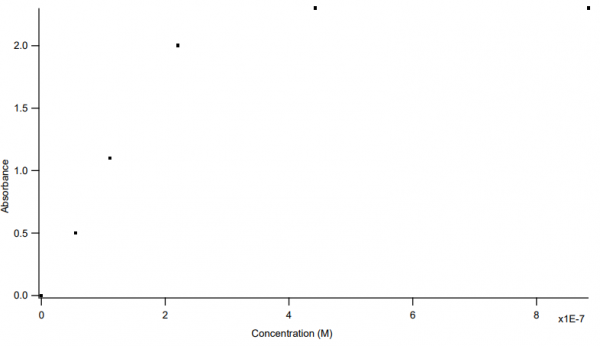 |
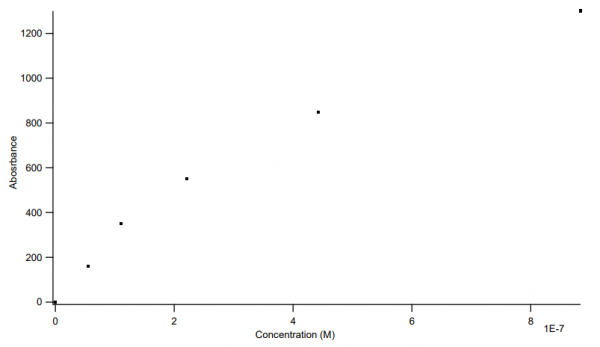
|
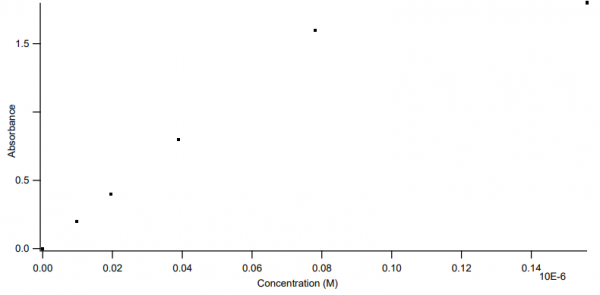 |
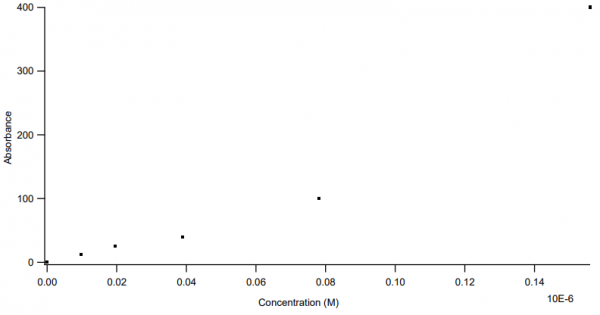
|
Discussion
Based on the graphs showing the relationship between absorbance and concentration, we are able to conclude that the UV/Vis is not able to properly document concentrations that have an Absorbance more than 2.0.The 3D representation of Blue Food coloring was also analyzed and the graph indicates that this food dye is not purely blue, the peaks that appear at about 5 mins and 7 mins down the separation indicate the presence of other substances, indicating that there could be a hint of red and potentially even green. This prepares the project for the next step, which is to discover what the other peaks represent and use similar techniques to see if the other food coloring is also mixed.
Conclusion
In Conclusion, our results indicate that the store bought food coloring are not purely the color they seem to the human eye, they consist of a mixture of a other food coloring. Our findings indicate that the blue food coloring is one of them. It would be more interesting to figure out what the other components of the food coloring are.
Future Directions
Justin Opam my partner will further the research as he may seem fit.
Literature References
https://www.sciencedirect.com/science/article/pii/S0308814603005934 http://www.adhdbasics.info/library/lib/Rowe1994.pdf https://www.acs.org/content/acs/en/education/resources/highschool/chemmatters/past-issues/2015-2016/october-2015/food-colorings.html https://www.ncbi.nlm.nih.gov/pmc/articles/PMC2957945/
Signature
Praburaman Mohan 5-13-2021
